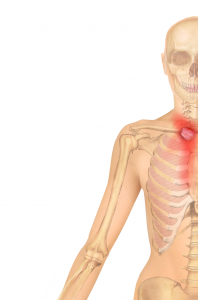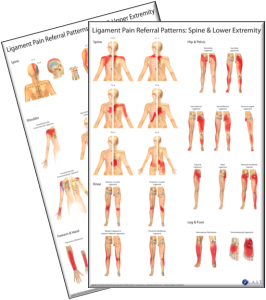Ligament Pain Referral Patterns
Over my 22yr career I’ve recognized a distinct, immediate and ongoing problem. My patients were complaining of pain referral patterns that didn’t seem to match up with the standard trigger points, dermatome or sclerotome patterns. For years I researched scientific journals and resources, while continually charting the referral patterns described to me by my patients. What I discovered was that the ligamentous articular system was an unrecognized and still continues to be an overlooked source of pain in our patients. These Ligament Pain Referral Patterns are relatively unknown to not just RMTs, but manual therapists of all kinds.
In the 1950’s George Hackett, MD researched ligamentous injuries, their pain referral patterns and treatment with Prolotherapy. His almost 20yrs of combined research and treatments, amounted to near 20,000 intraligamentous injections to over 1600 patients. Dr. Hackett published the book “Ligament and Tendon Relaxation Treatment by Prolotherapy” where he documented for the first time ligament pain referral patterns.
Current research is confirming that ligamentous articular structures/tissues have a rich nerve tissue supply and constant nociceptive sensory innervation. They transmit nociceptive information such as kinesthetic and danger messages which can be perceives as pain.
Research from the Bone and Joint Journal documents that within the femoral acetabular labrum, “pain-associated free nerve ending expression was located showing characteristic distribution profiles of nociceptive and pain-related nerve fibres, which may help in understanding the origin of hip pain.”
Studies have noted that the iliolumbar ligament has a rich nerve supply suggesting that the injury of this ligament might contribute to the low back pain. An Oxford Journal Rheumatology study “demonstrated that the sternoclavicular joint is capable of referring pain to areas distant from the joint.” The paper then states “knowledge of these referral patterns will enable the SCJ to be considered in patients with pain in these areas. “ It has been documented that the “PCLs have constant nociceptive sensory innervation and is the possible source of OA knee pain.”
“The American Journal of Orthopaedics advocate using pain maps as diagnostic tools in shoulder clinics. Pain maps can be further expanded as diagnostic aids in combined neck-and-shoulder pathology and in multiple shoulder pathologies.”
If you have patients complaining of referred pain that you just can’t figure out, if you treat joint dysfunction and want to explain more in depth the discomfort your patients are feeling, if you want to a add more value to your practice and your patients… this information will be an asset to you and your patients.
Ligamentous Articular Strain Technique courses instruct therapist to precisely and specifically treat joint dysfunctions. Each course includes pertinent information on each ligamentous articular structure and it’s pain referral pattern.
Purchase your Ligament Pain Referral Posters Here

Leave a Reply